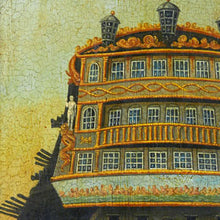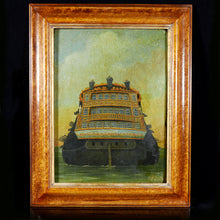18th Century English School Stern View of H.M.S. Namur, 1775
- Regular price
- £3,400
- Sale price
- £3,400
- Regular price
-
- Unit price
- /per
Adding product to your cart
Measurements: Overall: 45cm (17.75in) x 36cm (14in)
Oil on panel. Stern view of H.M.S. Namur (1756-1833). Board size: 35cm (13.75in) x 26cm (10.25in). Contained in a maple veneered frame.
H.M.S. Namur, 90-guns, was built at Chatham and launched in 1756. She was the flagship of Admiral Boscawen at the capture of French fortress of Louisbourg in 1758. At that time she was also home to Olaudah Equiano, aka Gustavus Vassa, an African slave purchased in America by Namur’s sixth Lieutenant. Equiano, who later was to become one of the heroes of the Abolition movement in Britain, never regretted his service in the Namur where he found unexpected friendship, adventure, education and a trade. Namur carried the affable Major-General James Wolfe across the Atlantic on his way to wrest Canada from French control - as Equiano recalled in his famous autobiography, “[Wolfe] often honoured me, as well as other boys, with marks of his notice; and saved me once a flogging for fighting with a young gentleman.”
Read more
In an age where naval engagements were rarely conclusive, Namur was Boscawen’s flagship at the decisive defeat of Admiral Clue’s French fleet (Battle of Lagos Bay) fought southwest of the Gulf of Cadiz, which contributed to the series of British victories gained during the annus mirabilis of 1759. Equiano was a powder monkey during this battle and in his autobiography describes in detail his experiences on Namur’s blood splattered middle gun deck. Namur was later the flagship of Admiral Sir George Pocock in the Battle of Havana (1762), and later still fought in the Battle of Cape St Vincent (1797) under the command of Captain James Hawkins-Whitshed - Namur being astern of H.M.S. Captain, under the command of then Commodore Horatio Nelson, in the early stages of the battle.
In 1802 Namur was razeed (cut down) to a 74-gun ship. She next took part in the naval engagement of 4 November 1805, (Battle of Cape Ortegal) when the remnants of the Combined fleets of France and Spain, that had escaped from Trafalgar, were engaged by Lord Strachan's squadron - Namur taking on and capturing the French warship Formidable. Between 1811 and 1814 Namur obtained another literary association when Jane Austen’s brother Rear Admiral Charles John Austen, took command. Namur was placed on harbour service in 1807 having participated in no less than nine fleet actions during the course of her 47-year career, and attained greater battle honours than Victory. Namur was finally broken up in 1833-34, and her timbers laid to rest beneath the Wheelwrights’ Workshop at Chatham Dockyard where they remained forgotten until 1995. They now form the centrepiece of the Command of Oceans exhibit.








